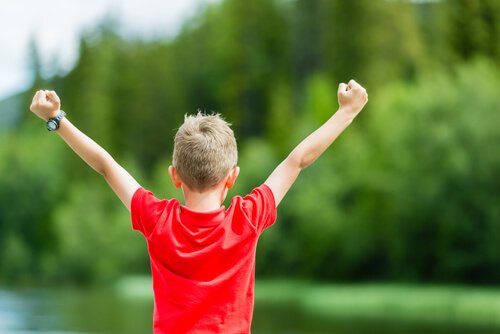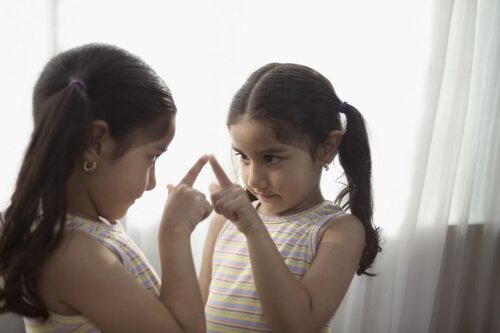How a Child's Self-Concept Develops

Our self-concept is essentially the image or perception that we have of ourselves. Unlike self-esteem, it can be expressed through words.
Like almost all human personality traits, an individual’s self-concept is formed from an early age. Because of this, it is a topic that demands our attention.
When you say to another person things like “I’m lazy,” “I’m good at math” or “I consider myself a tolerant person towards those who are different”, what you’re doing is quite simply expressing the vision and image you have about yourself. In other words, your self-concept.
Your self-concept is formed by how you view and judge your different characteristics and capabilities, and everything you acquire throughout your life.
We form these assessments through the relationship we have with the environment. As new challenges arise, and when we relate to other people around us, we become aware of our strengths and weaknesses.
“Too many people overestimate what they are not and underestimate what they are”
–Malcolm S. Forbes–
The difference between self-concept and self-esteem
It is worth pointing out the difference between these two terms which are often confused.
Self-concept is a fairly objective belief that we can put into words to describe ourselves in front of others. Self-esteem, on the other hand, is a personal assessment that isn’t expressed in words. To give you an example, we can say “I am a good athlete” (self-concept), but we can’t explain everything that this makes us feel inside (self-esteem).

How is self-concept formed in children?
As we noted previously, self-concept is something gradual that starts to form in childhood. The first “mirror” that children can observe and value themselves in is the family. That’s why it’s so important for parents to be careful with both criticism and praise.
Here are some recommendations to help your children develop a healthy self-concept:
- Point out their virtues in public, and correct them in private. Highlight their achievements, positive attitudes and skills so that they grow, and feel capable and confident in themselves. If there is something wrong that you need to point out, try to do it at home.
- Highlight what makes them unique. Each person is unique and has their own individual personality. Teach your children that they all have something that makes them who they are. Show them how they can value themselves.
- Stimulate their abilities. Instead of giving them solutions to everything, encourage them to find the solutions on their own. Teach them to question, to form their own opinions, and to take a stand on different topics. They will feel much more independent when they achieve it.
- Listen to their opinion. It’s important for children to know that their opinions count, and are considered valid. Otherwise, they’ll start to believe that their opinions are of no importance.
School: the second area where the child’s self-concept is formed
Just as the family is the first link in a child’s social life, school is the second. At school, children create their first independent connections with the outside world. It is where they learn to relate to all the other children around them. That’s why school is also an area where a child’s self-concept starts to develop. This happens in the following ways:
- By comparing their abilities with that of other students.
- Interaction and feedback with their peers.
- How their teacher evaluates them and their work.
- How they carry out activities that are expected of them.

Why is the development of self-concept important?
The image a person has of himself will determine his attitude toward many aspects of life. This encompasses his work life and his social life, and includes facets such as sexuality. It will be influenced by what we feel capable of doing or achieving.
Those who have a bad self-concept will have problems in their social relationships, how they express themselves and also in their educational or work performance. In severe cases, they can develop depression because of it.
Self-concept is a key factor in a person’s personality. If someone has a positive perception of himself, then he will usually turn out to be an optimistic and confident person. In addition, he will develop assertiveness and could even establish himself as a leader of a group.
If, on the other hand, his experiences lead him to form a negative self-concept, then he will grow up not trusting his own abilities. This could lead to low self-esteem, and that would produce many different negative effects throughout his life.
“You are very powerful, as long as you know how powerful you are”
–Yogi Bhajan–
In conclusion, we’ve learned that one of the best favors that parents can do for their children is to help them develop a good self-concept. A simple gesture or a word of support, even once a day, can help to form a sense of determination in children. If you do this then they’ll be able to achieve all the objectives they set for themselves.
All cited sources were thoroughly reviewed by our team to ensure their quality, reliability, currency, and validity. The bibliography of this article was considered reliable and of academic or scientific accuracy.
- Ternera, L. A. C. (2014). El desarrollo del autoconcepto en niños y niñas y su relación con la interacción social en la infancia. Psicogente, 17(31). http://revistas.unisimon.edu.co/index.php/psicogente/article/view/1470
- Loperena Anzaldúa, M. A. (2008). El autoconcepto en niños de cuatro a seis años. Tiempo de educar. Revista interinstitucional de investigación educativa, 9(18), 307-327. https://biblat.unam.mx/en/revista/tiempo-de-educar-revista-interinstitucional-de-investigacion-educativa/articulo/el-autoconcepto-en-ninos-de-cuatro-a-seis-anos
- Escrivá, V. M., García, P. S., & Delgado, E. P. (2001). Clima familiar y desarrollo del autoconcepto. Un estudio longitudinal en población adolescente. Revista Latinoamericana de psicología, 33(3), 243-259. https://www.redalyc.org/pdf/805/80533301.pdf
- Zabala, A. F., & Palacios, E. G. (2008). El autoconcepto infantil: una revisión necesaria. International Journal of Developmental and Educational Psychology, 2(1), 13-22. https://www.redalyc.org/pdf/3498/349832317001.pdf
This text is provided for informational purposes only and does not replace consultation with a professional. If in doubt, consult your specialist.








